The Brooklyn Mat Maker
How Sequential Evidence Building Solved What Traditional Genealogy Couldn't
When census records failed to distinguish between dozens of John Kennys in 1870s Brooklyn, traditional genealogy methods reached their limit. No unique birth dates. No distinct middle names. No reliable family stories. Just one Irish immigrant matmaker among countless others with the same name.
Then four words in a city directory changed everything: "Kenny Elizabeth, wid. Richard."


This simple designation — "widow of Richard" — appeared consistently across multiple years, creating the anchor point that traditional genealogy methods had missed.
"Kenny Elizabeth, wid. Richard"These four words unlocked a seven-year genealogical mystery and revealed a methodology that changed how we approach common surname research.
The dense Irish immigrant communities of 19th-century Brooklyn created the perfect storm for genealogical confusion. Common surnames, fragmented records, and early family tragedies combined to make some families virtually untraceable using traditional methods. The Kenny family represented this challenge at its most complex: dozens of John Kennys in the same city, limited DNA evidence, and a family story interrupted by death.
This case study documents how innovative methodology—sequential evidence building combined with occupational tracking—solved what seemed like an impossible research challenge.
The Seven-Year Challenge
2018-2019: When Standard Methods Hit a Wall
The Kenny research began like most genealogical investigations: census records, death certificates, and DNA testing. Brooklyn census records from 1850-1880 contained multiple John Kenny entries with similar ages, Irish birthplaces, and even similar occupations. Death records showed Richard Kenny dying in Brooklyn in 1854, but without clear connections to specific families.
Initial DNA testing yielded only one distant match through the Corcoran line—a 4th cousin connection that predated reliable records. Church records scattered across multiple Brooklyn parishes provided fragments but no definitive family links.
The Fundamental Problem: Traditional genealogy assumes that names, dates, and places provide sufficient identification. In immigrant communities with common surnames, these standard identifiers often prove inadequate.
2020-2021: Expanding the Search Without Success
Desperation led to broader source investigation. Immigration records showed Kenny arrivals throughout the 1840s-1850s Famine period, but linking specific individuals to Brooklyn families remained impossible. Marriage records provided witness names but no clear patterns. Property records showed various Kennys but without family connections.
Each new source seemed to create more possibilities rather than narrowing them. The research had reached the point where additional information only increased confusion rather than providing clarity.
2022: The Breakthrough That Changed Everything
Systematic analysis of Brooklyn city directories revealed something that had been overlooked in years of traditional research: specific family designations that didn't appear in census records.
One entry stood out: "Kenny Elizabeth, wid Richard, 75 Walworth"
This designation provided the crucial information missing from all other sources:
Elizabeth had been married to someone named Richard
Richard was deceased
This distinguished this Elizabeth Kenny from multiple other Elizabeth Kennys in the records
The Sequential Discovery Method
Discovery 1: The Widow Designation
Unlike generic directory entries listing only names and addresses, this specific designation created a research pathway. "Elizabeth, wid Richard" indicated:
A deceased husband named Richard who died in Brooklyn
A timeline for his death (before directory publication)
A specific family unit that could be tracked
This single piece of information transformed a generic "Elizabeth Kenny" into a specific individual with traceable family connections.
Discovery 2: The Complete Family Unit
Armed with knowledge that Elizabeth was Richard's widow, research could target Richard Kenny specifically rather than investigating every Richard Kenny in Brooklyn records.
This focused approach led to the most important discovery: the 1850 U.S. Census showing Richard Kenny as head of household with wife Eliza and sons James and John.
Why This Record Was Crucial: This census captured the complete Kenny family before Richard's 1854 death. It was the only document showing all four family members together, providing the baseline for tracking individuals through subsequent records.
Discovery 3: Twenty-Five Years of Family Consistency
With Richard, Eliza, James, and John identified as a family unit, their appearances in subsequent records could be tracked and validated across twenty-five years of census documentation:
1850 Census: Complete family with Richard as head
1855 New York State Census: Eliza with James and John after Richard's 1854 death
1865 Census: Continued household composition
1870 Census: Sustained family connections
1875 New York State Census: Eliza still maintaining family relationships
1880 Census: Eliza Kenny (55), John Kenny (31), Margaret Kenny (28), Elizabeth Kenny (10 months) - Final appearance before Eliza's death in 1888
This twenty-five-year consistency pattern across multiple independent census records eliminated any possibility of confusion with other Kenny families. The same individuals appeared together repeatedly across different enumeration years and districts, confirming family relationships beyond traditional genealogical doubt. The 1880 census further validated the connection between this John and Margaret McKenny, showing their marriage and infant daughter Elizabeth.
Discovery 4: Occupational Progression as Unique Identifier
With John Kenny definitively identified as Richard and Eliza's son, his career development provided the unique characteristic that distinguished him from all other John Kennys in Brooklyn:
Early Career: "Mat Weaver" (1870s)
Mid-Career: "Matmaker" (1879-1888)
Final Career: "Hatter" (death certificate, 1895)
This occupational progression appeared consistently across multiple sources over 13+ years, creating an unmistakable identifier that no other John Kenny in Brooklyn records could match.
Why Occupational Tracking Works
The Logic Behind the Method
In 19th-century urban communities, skilled trades provided more stable identity markers than names, ages, or even addresses. Consider the advantages of occupational tracking:
Consistency Across Sources: While names could be misspelled and addresses could change, occupational designations remained relatively stable and appeared consistently in multiple record types.
Skill Development Patterns: Career progression from "Mat Weaver" to "Matmaker" to "Hatter" represents logical skill development within related textile trades. This sequence would be extremely unlikely to appear randomly.
Community Context: The progression makes sense within Brooklyn's Irish immigrant community, where textile trades provided economic mobility and family business connections (John's brother James was also a hatter).
Temporal Consistency: The occupational progression tracked logically with life stages—entry-level work in youth, skilled designation in middle age, master craftsman status at career peak.
The Mat Weaver to Hatter Evolution
Understanding the specific trades helps explain why this progression serves as such a strong identifier:
Mat Weaving: Entry-level textile work creating floor mats, door mats, and similar items using hemp, straw, or rag materials. Required basic weaving skills but limited specialization.
Mat Making or Matmaking: Advanced manufacturing involving pattern design, material preparation, assembly, and quality control. Represented progression from basic weaving to complete product creation.
Hat Making: Sophisticated textile work requiring advanced skills in shaping, blocking, finishing, and fashion design. The natural evolution for someone with established textile expertise moving into higher-value products.
This career progression demonstrates both skill development and economic advancement—exactly the pattern expected for a successful immigrant craftsman.
The Career Path That Solved the Mystery
13+ Years of Documented Occupational Progression
Basic weaving skills
Hemp, straw, jute materials
Pattern design
Assembly & quality control
Fashion design & blocking
Master craftsman status
No other John Kenny in Brooklyn records could match this progression.
The logical skill development from basic mat weaving → advanced manufacturing → master hat making represents a career path that would be extremely unlikely to appear by coincidence.
Navigate through the documents that show how four simple words - 'John Kenny, mat maker' - unlocked a decades-long family mystery. Each record reveals how this Brooklyn craftsman's identity was finally confirmed through careful detective work.

1850 US Census with complete Kenny Family

1885 "Eliza, widow Richard" 39 Nostrand Brooklyn, New York, City Directory, 1885

1855 Census Ward 7 New York Kenny John
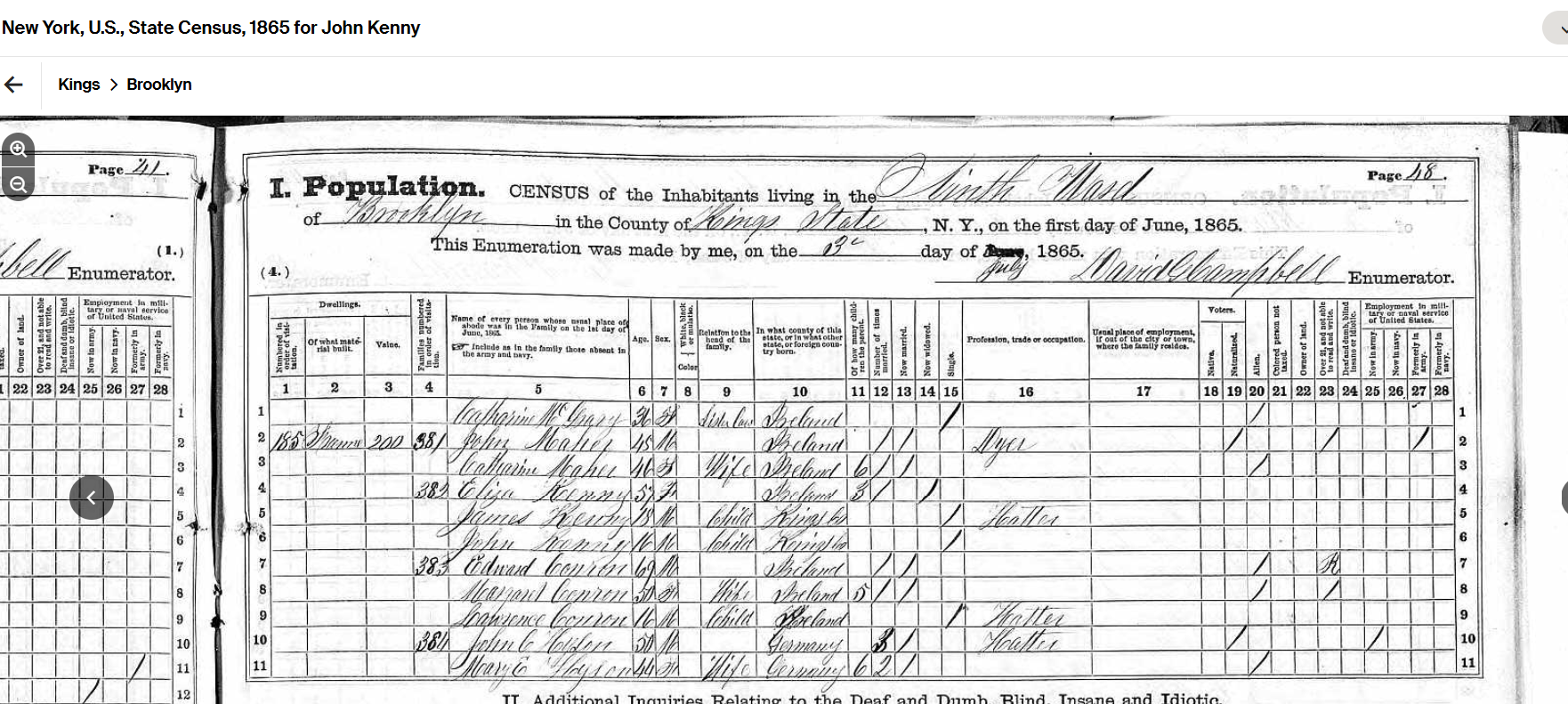
1865 New York Census Kenny John age 16

John Kenny Mat Maker 1870 US Census Ward 21 Brooklyn

1875 Census New York Kenny John mat weaver
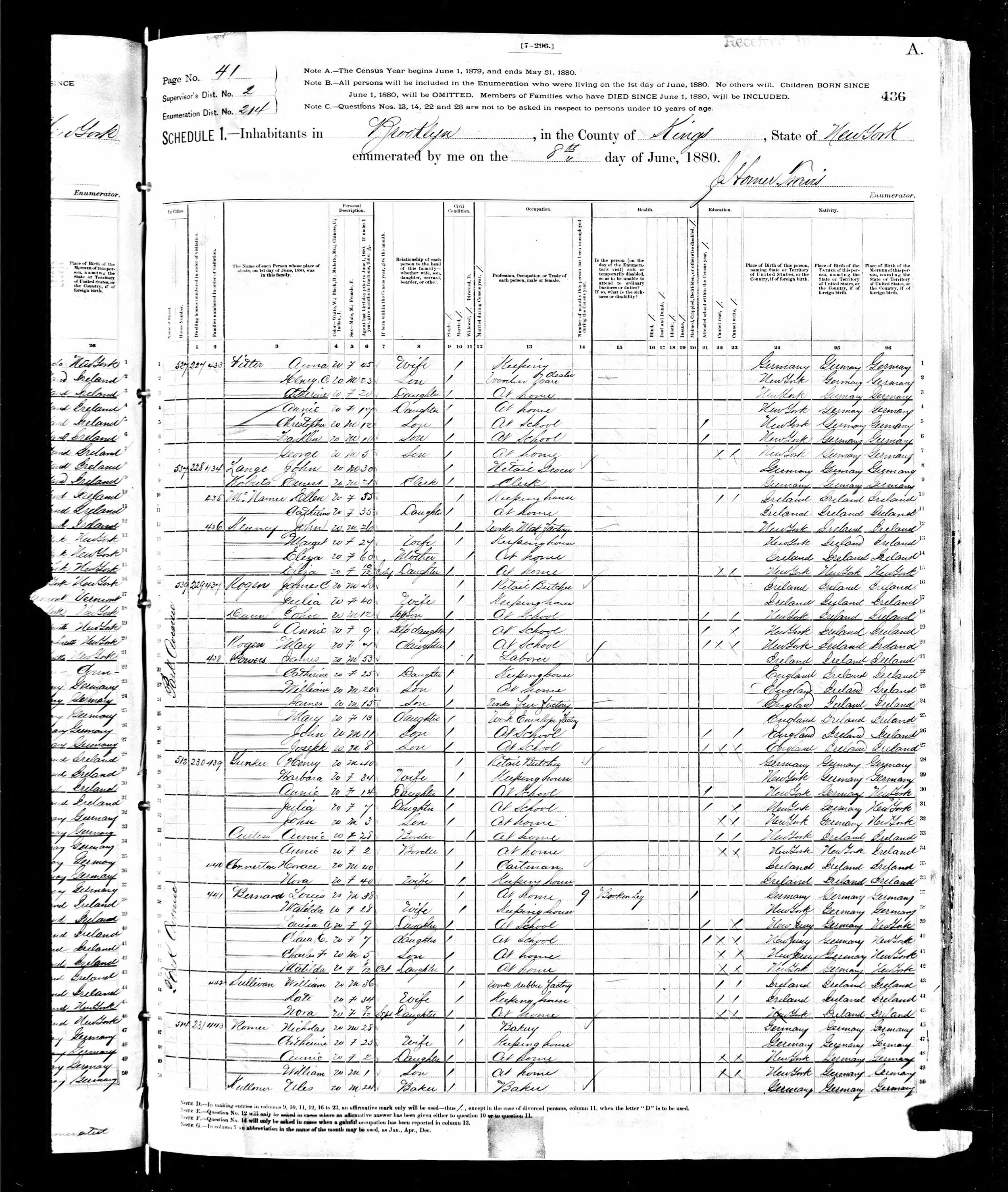
1880 US Census Kenny 436 Park Ave works Mat Factory

1880 Kenny John h r 75 Walworth matmkr Brooklyn, New York, City Directory, 1885,

Map of Ward 7 Brooklyn

1888 Kenny John matmkr 39 Hopkins 1888 Brooklyn Directory
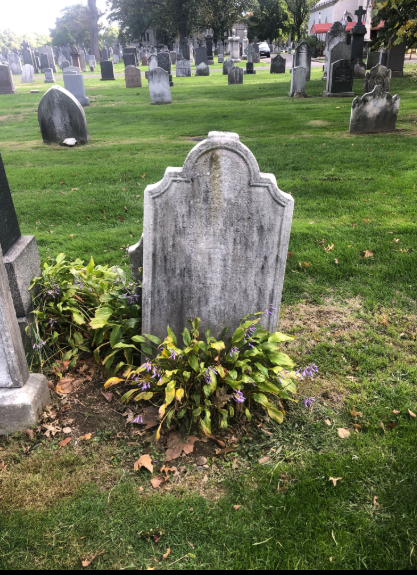
Find a Grave Photo of Kenney cemetery plot - Section PLOT Row 10 Plot 31 Graves 41' to...

Cemetery plot Richard Kenney Section PLOT Row 10 Plot 31 Graves 41' to...
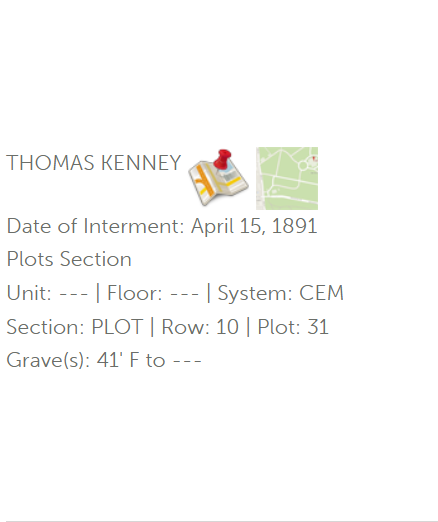
Cemetery plot Thomas Kenney Section PLOT Row 10 Plot 31 Graves 41' to...

C 1894-1896 Mary Agnes Robertson with beautiful hat
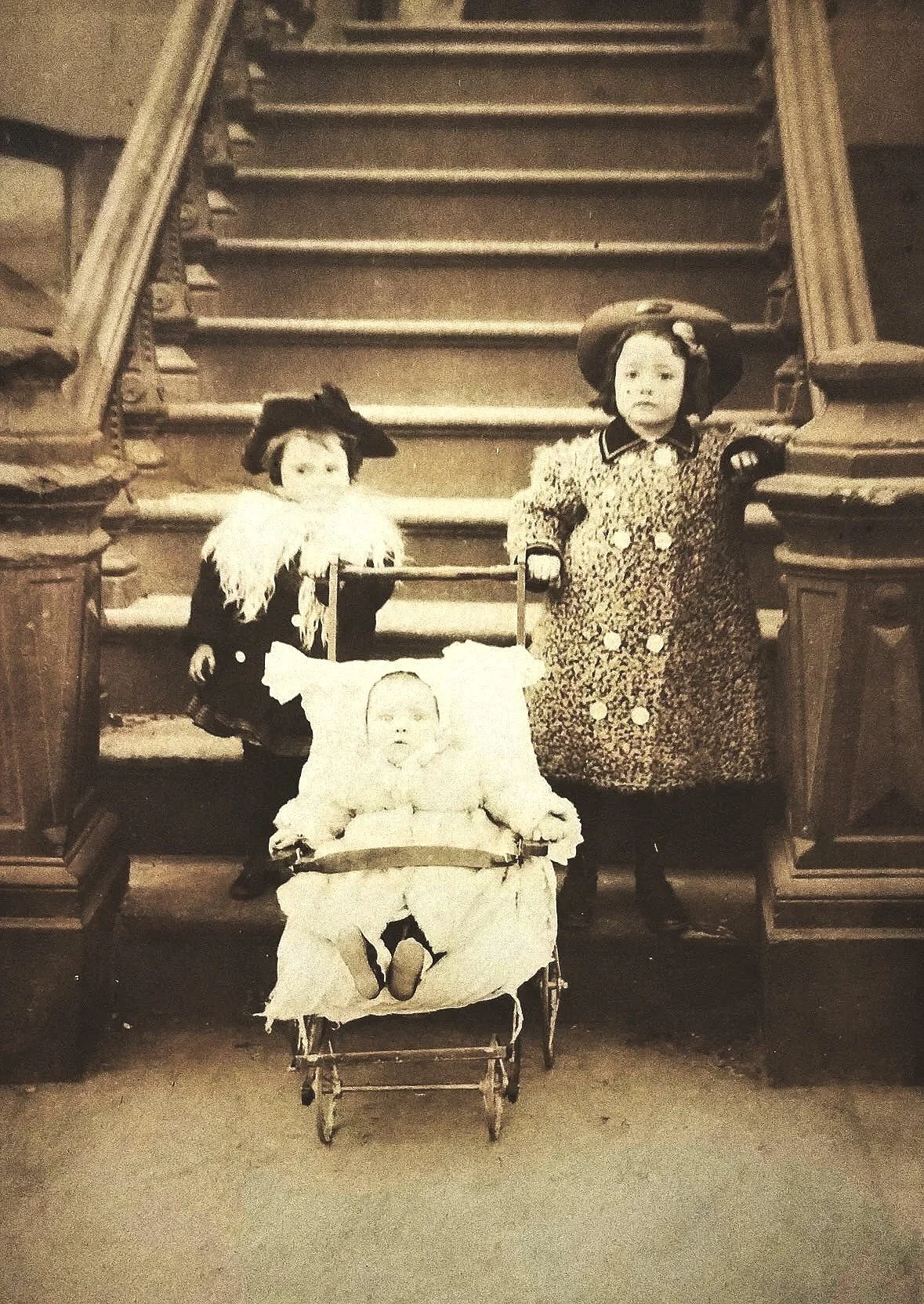
c 1910 Lillian J Robertson, Helen Robertson, and possible cousin Elizabeth Robertson with beautiful hats

1888 Death Certificate John Kenny occupation "hatter"
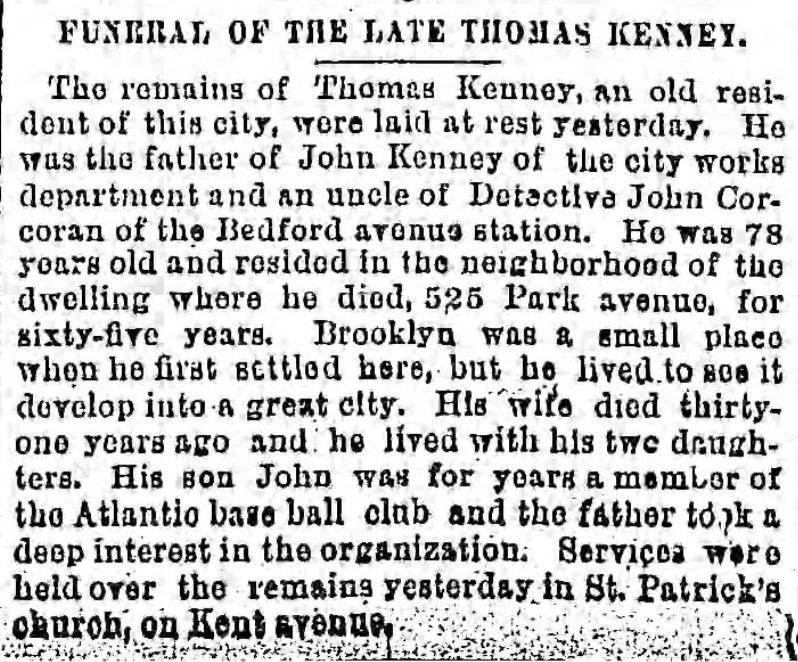
Multi-Source Validation Framework
Six Categories of Supporting Evidence
The strength of this identification comes from validation across multiple independent source types:
1. Brooklyn City Directories (1875-1888)
Annual occupational progression documentation
"Kenny Elizabeth, wid Richard" family designation
Address consistency in Brooklyn
Cross-year verification of information
2. U.S. Census Records (1850-1880)
Complete family structure baseline (1850)
Twenty-five-year household consistency (1855, 1865, 1870, 1875, 1880)
Geographic stability patterns
Age and birthplace consistency
3. Vital Records and Death Certificates
Richard Kenny death in Brooklyn (1854) with precise address
John Kenny death certificate listing "Hatter"
Address correlation between sources
Family relationship documentation
4. Cemetery Plot Analysis
Thomas Kenny: Sec PLOT, Row 10, Plot 31, Grave 41' FRONT
Richard Kenny: Identical plot coordinates
Family burial pattern confirmation
Independent relationship verification
5. Immigration and Community Records
Kenny family arrival patterns during Famine immigration
Settlement in Brooklyn Irish community
Economic circumstances matching family narrative
Community integration evidence
6. Visual and Photographic Evidence
Mary Agnes Kenny photograph (mid-1890s) wearing elaborate hat
Evidence of family prosperity and hat-making connections
Professional portrait indicating economic advancement
Continuation of family trade connections after John's death
Six Independent Sources Confirm One Identity
Each independent source type reinforced rather than contradicted the others, building an unshakeable case for correct family identification.
Cross-Source Correlation Patterns
The methodology's strength lies in how evidence from different sources reinforces rather than contradicts:
Timeline Correlation: Occupational progression aligns with census age development and family life stage changes.
Geographic Consistency: Directory addresses match census addresses match death certificate addresses in Brooklyn.
Family Network Validation: Eliza's consistent appearance with James and John across multiple decades confirms family structure.
Economic Progression: Career advancement correlates with family's improving economic circumstances and residential stability.
The DNA Confirmation Strategy: Thomas Kenny as the Missing Link
Beyond the Nuclear Family: Extended Network Validation
While the occupational tracking methodology had successfully identified John Kenny and the census records had established his nuclear family (Richard, Eliza, James, John), one crucial element remained: connecting this family to the broader Kenny network in Brooklyn and validating the identification through independent sources.
The breakthrough came through systematic cemetery plot analysis that revealed a relationship extending beyond the immediate family.
Cemetery Plot Documentation:
Thomas Kenny: Sec PLOT, Row 10, Plot 31, Grave 41' FRONT
Richard Kenny: Sec PLOT, Row 10, Plot 31, Grave 41' FRONT (identical coordinates)
In 19th-century burial practices, sharing identical plot coordinates typically indicated close family relationships - most commonly brothers. This discovery meant Thomas Kenny was likely Richard's brother, making him the uncle of John and James Kenny.
The DNA Validation Pathway
After six years of documentary research establishing the Kenny family framework, DNA testing yielded one significant result: a descendant of Francis Heffernan, a 4th cousin connection through the Corcoran line predating reliable records.
Initially, this genetic match seemed promising but insufficient - a single distant relationship that couldn't definitively validate the extensive documentary framework. However, the Thomas Kenny cemetery discovery transformed this limited DNA evidence into powerful confirmation.
The Critical Connection Chain:
Documentary Research: Occupational tracking identified correct John Kenny
Nuclear Family Establishment: 1850 census proved Richard, Eliza, James, John family unit
Extended Family Connection: Cemetery analysis proved Thomas and Richard Kenny were brothers
DNA Bridge: Thomas Kenny family connected to Corcoran line
Genetic Validation: Descendant of Francis Heffernan match confirmed entire Kenny family framework through Corcoran connection
Why This DNA Strategy Works
The Kenny case demonstrates a crucial principle for 19th-century immigrant research: comprehensive documentary research creates the framework that makes limited DNA evidence meaningful.
Traditional DNA Approach: Build family trees from genetic matches
Strategic DNA Approach: Use documentary research to create context that validates genetic evidence
Without the Thomas Kenny brother relationship established through cemetery records, the DNA match would have remained an unexplained genetic connection rather than validation of seven years of genealogical reconstruction.
Professional DNA Lesson: For immigrant families with limited genetic evidence due to demographic constraints, DNA often confirms rather than creates family connections. The Thomas Kenny discovery became the bridge that transformed sparse genetic data into comprehensive family validation.Research Timeline and Investment
Year-by-Year Development
Years 1-2 (2018-2019): Foundation and Frustration
Systematic census analysis across multiple decades
Death certificate collection and analysis (Richard Kenny died Brooklyn, 1854)
Initial DNA testing with limited results
Traditional source exhaustion without breakthrough
Years 3-4 (2020-2021): Source Expansion and Recognition
Brooklyn city directory comprehensive analysis
Immigration record investigation
Marriage and church record analysis
Breakthrough: "Kenny Elizabeth, wid Richard" discovery
Years 5-6 (2022-2023): Framework Building
1850 census discovery establishing complete family
Multi-census family consistency validation (1855, 1865, 1870, 1875, 1880)
Occupational tracking methodology development
Cemetery plot research and coordinate analysis
Year 7 (2024-2025): Confirmation and Documentation
DNA match validation through descendant of Francis Heffernan connection
Visual evidence integration and analysis
Cross-source validation completion
Methodology documentation for replication
Investment Reality
Total Research Hours: Approximately 500+ hours across seven years
Most Productive Period: Years 3-4 when sequential discoveries accelerated progress
Breakthrough Moment: Recognition that family designations provided overlooked identifiers
Validation Phase: Years 5-7 confirming methodology through multiple evidence types
The Seven-Year Research Journey
- Multiple John Kennys identified
- Census records collected
- DNA test: 1 distant match only
- Richard Kenny died 1854 (but which one?)
- Traditional methods exhausted
- Immigration records searched
- Marriage records analyzed
- Brooklyn directories examined systematically
- BREAKTHROUGH: "Eliza, widow of Richard" found!
- 1850 Census: Complete family found!
- 25-year consistency documented (1850-1880)
- Occupational tracking: Mat Weaver → Matmaker → Hatter
- Cemetery analysis: Thomas + Richard = brothers
- Sequential evidence methodology developed
- DNA match explained through Thomas Kenny connection
- Multi-source validation complete
- Methodology documented
- Templates created for other researchers
Applications for Other Researchers
When to Apply Sequential Evidence Building
This methodology works best for:
Common Surname Challenges: Situations where traditional name-based identification fails due to surname saturation in immigrant communities.
Limited DNA Scenarios: Cases where demographic bottlenecks, geographic dispersion, or historical factors limit genetic evidence.
Urban Research Opportunities: Locations with detailed city directories, multiple census records, and comprehensive vital record systems.
Fragmented Family Histories: Families where early deaths, geographic moves, or other disruptions interrupted generational knowledge transmission.
The Five-Phase Framework
Phase 1: Traditional Method Documentation (Months 1-12)
Systematically attempt and document standard genealogical approaches. Record what methods fail and why. This prevents repeating unsuccessful strategies and identifies research gaps.
Phase 2: Alternative Identifier Recognition (Months 12-36)
Look beyond standard genealogical markers for unique characteristics:
Family designations (widow, son of, nephew, etc.)
Occupational progressions and specializations
Address clustering and migration patterns
Associate networks and witness patterns
Phase 3: Sequential Discovery Building (Months 36-72)
Use each breakthrough to inform the next research strategy rather than treating discoveries as isolated findings. Build evidence chains where each piece supports and directs further investigation.
Phase 4: Multi-Source Cross-Validation (Months 60-84)
Ensure identified individuals appear consistently across different record types during overlapping time periods. Look for contradictions that might indicate incorrect identification.
Phase 5: Independent Confirmation (Months 84+)
Use DNA, photographic evidence, community records, or other independent sources to validate documentary conclusions rather than build family connections from scratch.
Should You Use Sequential Evidence Building?
(census, vital records, DNA)
been exhausted?
standard methods
surname problem?
fragmented records?
Continue to next check
(directories, multiple census, city docs)
methodologies
Continue
Apply methodology
Professional Research Implications
For Genealogical Practice
Time Investment Expectations: Complex cases require multi-year commitments with sustained methodological development rather than quick database searches.
Innovative Methodology Development: Sometimes breakthrough results require developing new analytical approaches specifically for challenging cases.
Client Communication Strategies: Set realistic expectations about timeline, complexity, and investment required for difficult genealogical problems.
Research Documentation: Maintain detailed records of methodology development for potential replication and client education.
For Client Services
Value Proposition Development: Demonstrate how professional research succeeds where amateur efforts fail through systematic methodology and sustained investigation.
Investment Justification: Complex cases justify higher research fees due to time investment and innovative approach requirements.
Outcome Management: Position breakthrough results as culmination of systematic professional process rather than lucky discoveries.
Legacy Creation: Transform individual family research into broader educational resources and methodological contributions.
From Research to Methodology: The Template Collection
The Brooklyn Mat Maker investigation produced ten comprehensive research templates that enable other genealogists to apply similar approaches:
Occupational Tracking Worksheet - Career progression analysis
Multi-Source Timeline Template - Evidence coordination framework
Cemetery Plot Research Guide - Burial location analysis
DNA Strategy Worksheet - Limited match situation planning
Brooklyn Ward Research Guide - Geographic context tools
Research Timeline Tracker - Multi-year project documentation
Irish Immigration Network Framework - Community analysis
Brooklyn Directory Search Strategy - Systematic directory methodology
Address Clustering Analysis - Settlement pattern tracking
Common Surname Differentiation Matrix - Individual comparison system
These templates transform the Kenny family breakthrough from isolated success into replicable methodology for the professional genealogical community.
The Broader Impact: Beyond Individual Family History
Community and Historical Understanding
The Kenny family research revealed patterns extending far beyond individual genealogy:
Irish Settlement Networks: Understanding how families clustered in specific Brooklyn wards and maintained community connections despite individual tragedies.
Economic Mobility Patterns: Documenting how skilled trades provided advancement opportunities for immigrant families and contributed to long-term community prosperity.
Family Resilience Strategies: Analyzing how Irish immigrant women like Eliza Kenny maintained family stability despite early widowhood and limited resources.
Trade Development Evolution: Tracking how textile skills transferred between related industries and enabled career progression within immigrant communities.
Methodological Innovation
The sequential evidence building approach developed for the Kenny case provides frameworks applicable to other challenging genealogical problems:
Common Surname Solutions: Systematic approaches for distinguishing between individuals sharing names in the same communities and time periods.
Urban Immigrant Research: Specialized techniques for navigating complex city records, directory systems, and community documentation.
Limited DNA Integration: Strategic approaches for maximizing value from sparse genetic evidence through comprehensive documentary preparation.
Multi-Decade Family Tracking: Methods for maintaining family connections across extended time periods despite record gaps and geographic mobility.
Conclusion: When Research Becomes Legacy
The Brooklyn Matmaker case demonstrates that some genealogical challenges require more than expanded database searches or additional DNA testing. Complex family mysteries often demand sustained professional commitment, methodological innovation, and strategic evidence building over multiple years.
The seven-year Kenny investigation shows that breakthrough results frequently come from developing new analytical frameworks specifically designed for difficult cases rather than applying traditional methods more thoroughly.
Most importantly, the methodology developed for one family creates resources and approaches that benefit the broader genealogical community. The Kenny research produced not just one solved family mystery, but a replicable framework for addressing similar challenges facing other researchers.
This transformation from individual research to community resource represents the highest value of professional genealogical work: solving immediate problems while building knowledge that benefits future investigations.
The Brooklyn Matmaker story proves that when traditional approaches fail, innovation combined with persistence can turn seemingly impossible challenges into breakthrough successes—and those successes into lasting methodological contributions.
Related Content:
Read "Four Words That Solved a Seven-Year Mystery" – Discover how "Eliza, widow of Richard" unlocked an impossible genealogical puzzle
Read "Four Generations in Hats: A Brooklyn Story of Resilience" – The complete family narrative spanning 1850-1950
Read “Woman in the Portrait: Aunt Maime’s Story” - For 90 years, her portrait was preserved…
Read “The Tintype in the Box: Solving a 150 Year Old Family Mystery-How a nameless Victorian photograph finally revealed its secret
This research methodology and complete template collection are available for genealogists working with similar complex cases requiring innovative analytical approaches.
Tags: Brooklyn Genealogy, Irish Immigration, Occupational Tracking, Common Surname Research, Genealogy Methodology, Sequential Evidence Building, Brooklyn Ward History, Professional Genealogy
